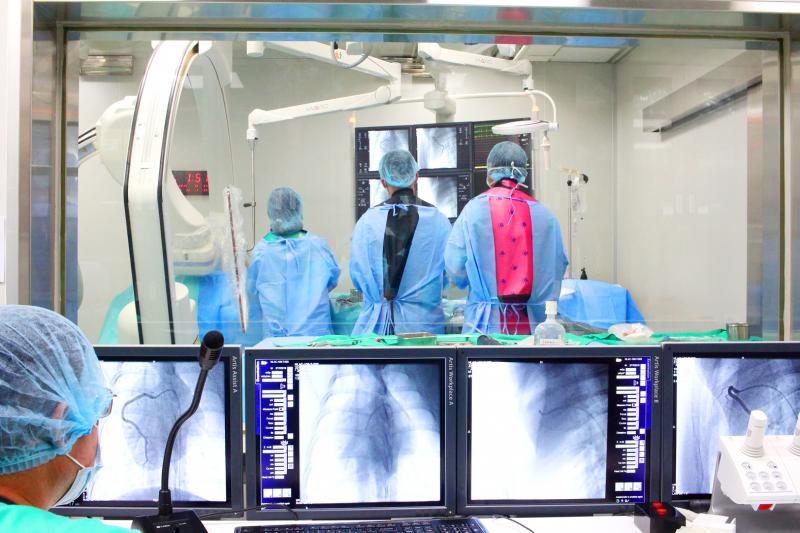A blood vessel imaging system installed at the National Laboratory Animal Center could help researchers develop a treatment for cardiovascular disease in humans, the center said yesterday.
The center, based at the National Biotechnology Research Park in Taipei’s Nangang District (南港), is one of the National Applied Research Laboratories’ (NARL) eight centers.
Center director Yu Chun-Keung (余俊強) and Hung Kuan-yu (洪冠予), the superintendent of National Taiwan University Hospital’s Hsinchu Branch, yesterday signed a memorandum of understanding (MOU) at a ceremony in Taipei, with NARL president Wang Yeong-her (王永和) serving as a witness.

Photo courtesy of the National Laboratory Animal Center
Cooperation between the two institutions would speed up the clinical application of innovative techniques developed by the hospital, while NARL offers other research resources related to semiconductor, information and communications technologies, Wang said.
Demand for oncological, cardiovascular and neurological testing for animals has been increasing, so the center last year spent NT$30 million (US$989,576) installing a biplane angiography system in its laboratory at the Hsinchu Biomedical Science Park, center associate research fellow Su Yu-chia (蘇裕家) said.
The system can provide 3D X-ray images of animals in real time, which enables veterinarians to see the structures of animal organs while performing surgery and increases the success rate of the surgeries, he said.
Techniques such as computed tomography and magnetic resonance imaging also produce 3D images, but they do not allow surgeons to take images during surgery, Su said.
The MOU would allow physicians at the hospital who want to develop new treatments for cardiovascular disease in humans to use the center’s imaging system to first try the treatments on laboratory animals, he said.
The institutions would jointly develop innovative medical techniques, such as navigating inside bronchial tubes, treating various heart arrhythmias and diagnosing intracerebral hemorrhages, he said.
They would share data from certain experiments that employed the imaging system, Su said, adding that the biplane angiography system could be rented by researchers at other institutions.
The center, whose headquarters is in Taipei, has a preclinical testing lab at the Hsinchu Biomedical Science Park, as well as a preclinical animal care and surgery facility at the Southern Taiwan Science Park (南部科學工業園區) in Tainan.

Auckland rang in 2026 with a downtown fireworks display launched from New Zealand’s tallest structure, Sky Tower, making it the first major city to greet the new year at a celebration dampened by rain, while crowds in Taipei braved the elements to watch Taipei 101’s display. South Pacific countries are the first to bid farewell to 2025. Clocks struck midnight in Auckland, with a population of 1.7 million, 18 hours before the famous ball was to drop in New York’s Times Square. The five-minute display involved 3,500 fireworks launched from the 240m Sky Tower. Smaller community events were canceled across New Zealand’s

The Ministry of Foreign Affairs (MOFA) yesterday said it is closely monitoring developments in Venezuela, and would continue to cooperate with democratic allies and work together for regional and global security, stability, and prosperity. The remarks came after the US on Saturday launched a series of airstrikes in Venezuela and kidnapped Venezuelan President Nicolas Maduro, who was later flown to New York along with his wife. The pair face US charges related to drug trafficking and alleged cooperation with gangs designated as terrorist organizations. Maduro has denied the allegations. The ministry said that it is closely monitoring the political and economic situation

‘SLICING METHOD’: In the event of a blockade, the China Coast Guard would intercept Taiwanese ships while its navy would seek to deter foreign intervention China’s military drills around Taiwan this week signaled potential strategies to cut the nation off from energy supplies and foreign military assistance, a US think tank report said. The Chinese People’s Liberation Army (PLA) conducted what it called “Justice Mission 2025” exercises from Monday to Tuesday in five maritime zones and airspace around Taiwan, calling them a warning to “Taiwanese independence” forces. In a report released on Wednesday, the Institute for the Study of War said the exercises effectively simulated blocking shipping routes to major port cities, including Kaohsiung, Keelung and Hualien. Taiwan would be highly vulnerable under such a blockade, because it

UNRELENTING: China attempted cyberattacks on Taiwan’s critical infrastructure 2.63 million times per day last year, up from 1.23 million in 2023, the NSB said China’s cyberarmy has long engaged in cyberattacks against Taiwan’s critical infrastructure, employing diverse and evolving tactics, the National Security Bureau (NSB) said yesterday, adding that cyberattacks on critical energy infrastructure last year increased 10-fold compared with the previous year. The NSB yesterday released a report titled Analysis on China’s Cyber Threats to Taiwan’s Critical Infrastructure in 2025, outlining the number of cyberattacks, major tactics and hacker groups. Taiwan’s national intelligence community identified a large number of cybersecurity incidents last year, the bureau said in a statement. China’s cyberarmy last year launched an average of 2.63 million intrusion attempts per day targeting Taiwan’s critical